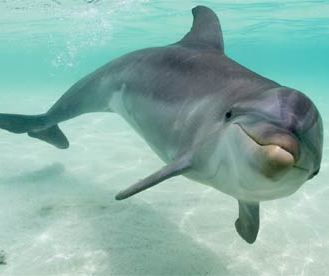
Common bottlenose dolphin, or Atlantic bottlenose dolphin (Tursiops truncatus)
Phylum —chordata
Class — mammalia
Order — artiodactyla
Family — delphinidae
Genus – tursiops
Appearance
The Common bottlenose dolphin is grey in color and may be between 2 and 4 m (6.6 and 13.1 ft) long, and weighs between 150 and 650 kg (330 and 1,430 lb). Males are generally larger and heavier than females. Dolphins have a short and well-defined snout that looks like an old-fashioned gin bottle, which is the source for their common name.
Like all whales and dolphins, though, the snout is not a functional nose; the nose has instead evolved into the blowhole on the top of their heads. Their necks are more flexible than other dolphins' due to five of their seven vertebrae not being fused together as is seen in other dolphin species.
Habitat
The Common bottlenose dolphin is found in all of the world's seas, both tropical and temperate. Some populations remain in one area, while others migrate extensively. Some populations live are offshore and some inshore.
Behavior
The bottlenose dolphin is a very social animal. Typically living in groups ranging from just a few individuals to more than 100, they form several types of groups, which include nursery groups, juvenile groups, and groups of adult males. They engage both in aggressive behavior, such as biting, ramming, and tail slapping; and behavior of bonding and acceptance behavior, such as rubbing and stroking. They emit a vast range of squeaks, grunts, and whines, which are categorized in three groups: echolocation clicks, whistles and pulse sounds. Dolphins also communicate through touch.
Diet
A bottlenose dolphin usually eats a wide variety of food including crustaceans, fish, and squid. Each day an adult can eat 15-30 pounds (6.8-13.5 kg) of food. They do not chew their food with their teeth. Instead, they swallow it whole and head first in order to avoid spines that feature on many of the fish they like to eat.
Reproduction
Bottlenose dolphins are polygamous. Breeding can take place at any time of the year, but occurs mostly in the spring, with a smaller peak in the fall. The gestation period lasts for about 12 months, after which one calf is born. A female nurse until the calf reaches 18-20 months. These dolphins give birth every 3 to 6 years, females usually falling pregnant soon after weaning, and they can continue to give birth until their late forties. The calves can be born any time during the year, with most born during the warmer months. Females are usually reach sexual maturity at an age between 5 and 10 years, and males between 8 and 13 years.
The average life expectancy of Common bottlenose dolphins is about 17 years old, but in captivity they have been known to live to up to 51 years old.
Incaptivity
Bottlenose dolphins, perhaps, are better than other species tolerate captivity, live in large aquariums for a long time, are easy to train and often breed.
Standards of keeping are developed and controlled by national and international associations. The presence of dolphins in pools without frequent water changes is constantly associated with the risk of developing intestinal diseases that require medical intervention. There are minimum dimensions for the pool: 10 meters long and 2.5 meters deep.
In dolphinariums, marine mammals are kept either in special pools, or in networked marine enclosures, or in fenced-off sea coves, or in coastal lakes with sea water. However, aquariums differ in their size, maintenance, and their convenience for a dolphin.
In nature, dolphins swim up to 160 kilometers a day, and in captivity they often live in very small pools. Wild dolphins can be underwater for up to 30 minutes, and they usually spend only 10-20% of their time on the surface. But because the pools are very small, they spend more than half of their time on the surface of the water. Experts believe that this is the reason why most dolphins in captivity weaken their dorsal fins.
In order to keep marine animals in captivity, keepers need to create the conditions in which animals are used to exist in their natural environment. This means that the water in the pool must be marine and always spotlessly clean.
 Russian
Russian
 English
English


















